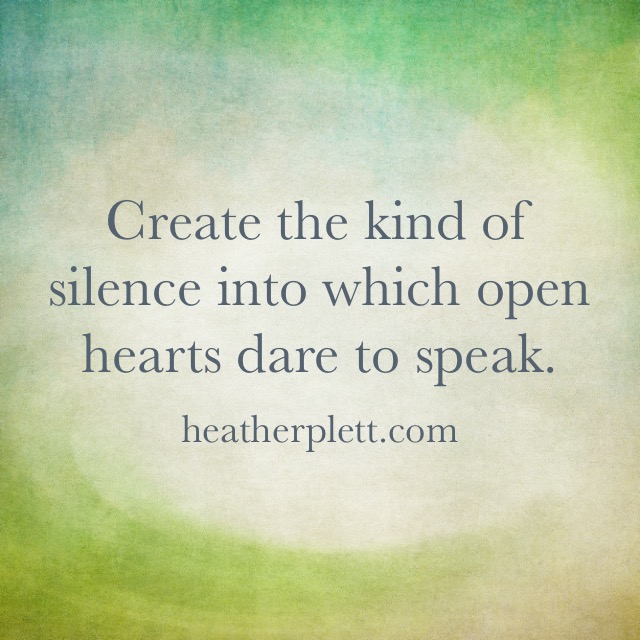“The art of conversation is the art of hearing as well as of being heard.” ― William Hazlitt

The wedding I officiated on the weekend took place in a circle. The bride and groom and I stood in the centre, with the guests gathered around us.
After I had shared a few words of wisdom about marriage, I read a blessing and then passed a talking piece (a stone on which I’d printed their names) around the circle inviting each person to speak their own one-sentence blessing to the couple. If they didn’t feel comfortable speaking, they had the option to simply hold the stone for a moment and offer an unspoken blessing.
It was a beautiful and simple ritual that felt like the couple was being held in a giant container of love by their community.
As I said in this piece last November, the talking piece isn’t magic, but “what IS magic is the way that it invites us to listen in ways we don’t normally listen and speak in ways we don’t normally speak.”
When a talking piece goes around the circle, the person who holds it is invited to “speak with intention”. Everyone else is invited to “listen with attention” and not interrupt or ask questions. Everyone in the conversation is invited to “tend the well-being of the circle”. (Those are the three practices of The Circle Way.)
A talking piece conversation has a unique quality to it. There is more listening, less interrupting,  more pausing, and, almost always, more vulnerability than ordinary conversations. Yes, some people get nervous about the talking piece (because it puts them on the spot and feels like pressure to say something important), but when they get used to it, (and when they realize that anyone is welcome to pass the talking piece without speaking) almost everyone acknowledges that the talking piece brought something special into the space that they’ve rarely experienced before.
more pausing, and, almost always, more vulnerability than ordinary conversations. Yes, some people get nervous about the talking piece (because it puts them on the spot and feels like pressure to say something important), but when they get used to it, (and when they realize that anyone is welcome to pass the talking piece without speaking) almost everyone acknowledges that the talking piece brought something special into the space that they’ve rarely experienced before.
The talking piece is not meant for every conversation, but I believe it should play a more significant role in many of our conversations. Here’s why:
1. The talking piece invites us to listen much more than we talk. When in a circle with a dozen people, I have to listen twelve times as much as I talk. That’s a very good practice. Listening opens our hearts to other people’s stories. It invites our over-active minds and mouths to pause and be present for people who need to be witnessed. And when it’s our turn to talk, we know that we are being listened to just as intently.
2. The talking piece encourages us to get out of “fix-it” mode. When a friend shares a problem with us, it usually feels more comfortable to jump in with a solution than to sit and really listen. But unless that friend has asked for advice, what she/he probably needs more than anything is a listening ear. The talking piece doesn’t allow us to interrupt with our version of “the truth”. Often, simply because they’ve been heard in a deeper way than they’re used to, people walk away from the circle having figured out their OWN solutions for their problems.
3. The talking piece makes every voice equal. Nobody has the podium in a circle. Nobody stands on a stage. Each voice makes a valuable contribution to the conversation and none is more important than the others. With so many race issues happening recently (especially in the U.S. and Canada), I like to imagine what might happen if more people were to sit in circle with people of different races. What if we mandated interracial circle conversations for every high school student? What if students couldn’t graduate unless they’d spent time learning to listen to stories told by people who are different from them? What if Dylan Roof, for example, had sat in a weekly circle listening to stories from the black community? Might that have changed last week’s outcome?
4. The talking piece invites us more physically into the conversation. There’s something special about holding an object in your hand that has been passed there from hand to hand around the circle. It invites us to be present in not just our heads but in our bodies. It invites us to sink physically into the conversation, engaging in a deeper way because our hands are engaged along with our hearts.
5. The talking pieces creates the silence into which open hearts dare to speak. There’s a level of vulnerability that shows up in the circle that is rarely present in other conversations. Because the talking piece invites us to slow down and be more intentional, we don’t just talk about the weather or yesterday’s shopping trip. We talk about things that are real and we show up authentically for each other.
Have you had experience with a talking piece? I’d love to hear about it.
If you haven’t experienced it yet, don’t be afraid to try. Yes, you might get some funny looks from your family or friends when you pull out a stone, a stick, or even a pen and invite them to pass it around the circle, but there’s a very good chance – if they’re openhearted and authentic – that they will be surprised at what it brings to the conversation.
Interested in more articles like this? Add your name to my email list and you’ll receive a free ebook, A Path to Connection. I send out weekly newsletters and updates on my work.
